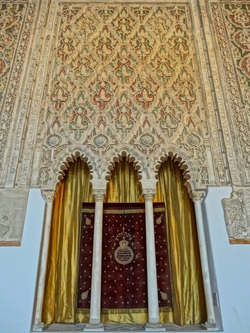
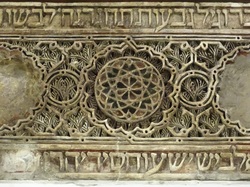
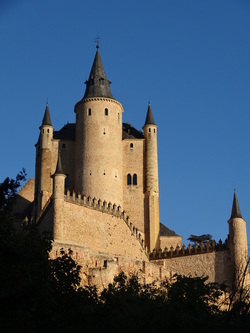
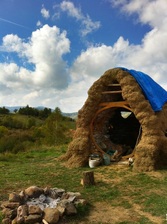
In our post on Andalusia, we started the story of the Jews in Spain during the rule of the Moorish Kingdoms. As we traveled to the central region of Spain to visit the capital of Madrid, we will end that story. Previously we learned that the Moorish Kingdoms were tolerant of the Jews, creating a golden age where Jewish culture and art thrived. But as more conservative factions came to rule in Moorish Spain, Jews fled to the territory of the Christian Kingdoms, where they were not killed largely because those kingdoms needed them in the fight against the Moors.  The Ark in El Transito Synagogue Much of the history comes to a head in Toledo. In 1085, Alfonso VI welcomed the fleeing Jews to Toledo by granting Jews equality with Christians and even some rights of the nobility. 40,000 Jews served in Alfonso VI’s army against the Moors, until a key battle was lost in 1108. The Jews were blamed and a riot broke out that killed many Jews and saw their homes and synagogues burned down while Alfonso lay on his deathbed, helpless to stop the madness. For the next 300 years patterns like this would continue where Jews were given a modicum of power by one ruler, only to be massacred and exiled by the next. By 1391, anti-Semitism reached a fever pitch and Jews were butchered in Seville, Cordoba, and Toledo. Corpses of women and children lay heaped in the streets and in destroyed synagogues.  Stucco work - El Transito From the massacres rose to popularity the Dominican Vincent Ferrer, who forced Jews to either convert or be forced to live in ghettos where nearly any livelihood was illegal as was flight from the country. But as Jews did convert, no one believed their faith and hatred of these “New Christians” was the dominant attitude. Thus were sown the seeds of the Spanish Inquisition, aimed at finding out if converted Jews (conversos) were authentic in their faith. By 1492, hatred of Jews was so strong that Isabelle and Ferdinand signed the edict of expulsion, which forced all unconverted Jews to leave the country forever, with all of their property and wealth confiscated by the state. The majority (90,000) fled to Turkey and the Ottoman Empire while 20,000 others died in the process of fleeing. Those converses who stayed were subjected to the torture and persecution of the Spanish Inquisition, which didn’t fully end until 1834. But despite the sadness about the oppression of minorities in medieval Spain, there were many beautiful sites to be seen. In Madrid the Palacio Real (Royal Palace), the Botanical Gardens, and the numerous beautiful piazzas were all impressive. In Toledo, the mudejar style of the surviving synagogues was beautiful and the huge cathedral there is impressive.  Alcazar in Segovia But perhaps most memorable for us was the picturesque town of Segovia, whose old city was fed by an aqueduct that reaches 28 meters at its tallest point. Built during Roman times to supply a fort on the hilltop that would become the city, the aqueduct uses no mortar (it is only stacked stones) and is truly an act of engineering genius, testified to by the fact that it still stands 2,000 years after its construction. It is amazing! The Alcazar (palace) in Segovia is equally beautifully – its Romantic style towers climbing into the sky on the site of the old Roman fort. Plopped down in the middle of the town between the Alcazar and Aqueduct is the last great Gothic Cathedral in Spain, also stunning. Walking down into the countryside in order to get views of the Alcazar and Cathedral as the sun set on the city was one of our favorite times in Spain. After the sun went down we sped home on our first trip ever on a high speed train – a mere 30 minute journey. After our day trips to Toledo and Segovia, we spent the day in the botanical gardens of Madrid, enjoying the landscaping and the beauty of the crystal palace there. Then it was off on a night bus to Barcelona, where we would have one of our most dangerous adventure yet! See all the pics of Madrid, Toledo and Segovia by clicking here.  Mudhouse Postscript: We are back in Bulgaria now and getting ready for our trip to India. But if you want to see some pics of our mountain adventure in Bulgaria with our friends Kaloyan and Rumiana, click here. We had great times visiting a Bulgarian masterpiece of a house (from the days of Turkish occupation) and helping to build a hobbit-like mudhouse at the Future Now volunteer project high up in the hills. After getting back from our trip, we spent a 13 hour day making homemade lutenitza, inspired by our Barcelona friends Simona and Walter! If you are friends or family on Flickr you can click on the link to see the pics!
0 Comments
How is it that one tiny area of land can embody man’s greatest achievements and his most despicable depravity? The most Southwesterly part of Europe manages to do just this. We arrived in Lagos, Portugal and were dazzled by its gorgeous coastline replete with fresh seafood restaurants servings up the famous sardines native to the area. It is from Sagres, just a few kilometers away, that Prince Henry the Navigator set up his famous school that would usher in the age of Discovery. Sagres sits on the cliffs overlooking the Atlantic and was long considered the edge of the world by sailors. It was thought that to sail far beyond its shores would lead only to monsters, darkness, and to boats falling off the very face of the earth. Henry’s school accumulated the knowledge that would allow for this “edge” to be challenged. Through the development of an improved astrolabe, improved maps, and the new ship design of the caravel, he was able to send its students to places hitherto uknown in the world. Columbus studied there before getting sponsorship by Spain for his voyage to the New World. In 1488 Bartolmeu Dias was the first man to round the Cape of Good Hope and in 1498, Vasco Da Gama opened up the sea route to India, both after studying at Henry’s school. 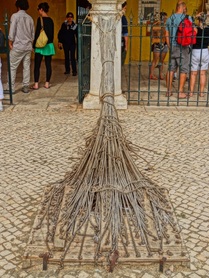 And yet the area has a nefarious past as well. For it was here in 1444, that Europe’s first Slave market (the Mercado de Escravos) was opened. From Lagos, thousands of Africans were dispersed through Europe, unjustly forced to perform labor after being snatched from their homes. The famously religious Prince Henry (who was part of the Order of Christ, deriving from the Knights Templar) received one-fifth of the selling price for each slave as he was the major sponsor of the expeditions to Africa. The image to the left depicts the front of the slave market, where ropes have been strung together to represent that first shipment of 275 slaves brought into Europe in 1443. 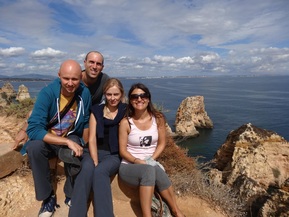 With these themes juxtaposed in our minds, we met up with some wonderful couchsurfers in Lagos who made our stay there truly memorable. Lijana and Andrius are Lithuanians who are traveling the world, living in different locations, and supporting themselves remotely with their website that sells Halloween Costumes (check out their site if you need a costume!). They were an inspiring couple to meet with as they took their wanderlust and made it into a viable profession while also generously sharing their home with surfers like us. But beyond serving us delicious vegetarian meals, they also picked us up from our hike along to the coast to the gorgeous Ponta da Piedade (the Point of Piety) and drove us up to Sagres, where we saw the cliffs that seaman for years considered the edge of the world. But after a quick photo where all the tourists were, we got to go a lot deeper. Adrius & Lijana are avid rock climbers and discovered some great routes just down on the famous cliffs. They took us to their favorite spot, an isolated cove where you can climb the sheer rock walls while the crashing waves and setting sun provides an utterly picturesque background (as you can see from our numerous photos and videos on our Flickr page). As we climbed at the edge of the world with our new friends, we felt a tinge of inspiration and trepidation that those long-gone sailors must have felt looking out into the unknown before setting off on their journeys. 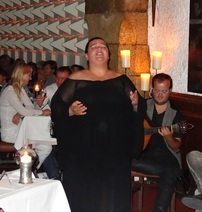 Fado Singer With so many sailors never returning from their journeys to the unknown, a musical art form known as Fado would eventually develop. Translated as “fate” Fado is a mournful, soulful style of singing where the singer bemoans the tragedies of the sea, unrequited love, and our inability shake loose from what fate offers us. Upon arriving in Lisbon, the capital of Portugal, we attended a Fado concert our first night to see what is all about. We enjoyed the music and the singers’ voices, though the current tradition of Fado is far from the spontaneous plebian singing that dominated the docks and taverns of old Lisbon. Rather, Fado is now sung in classy restaurants where a minimum amount of money must be spent to even sit down. The rest of our time in Lisbon was spent exploring the old neighborhood of Alfama, the gorgeous Manueline sea-inspired architecture of Jerónimos Monastery, Belem Tower, and the Monument to the Discoveries. The intricate detail work in the carvings of the cloister at Jerónimos Monastery were particularly impressive. We also filled ourselves up with fried cod-balls and sandwiches in the local food bars, an interesting cultural experience in which locals will eat a bite and a beer quickly at the bar rather than pay more to sit down at the tables outside. But in the end we grew tired of Portuguese food and were delighted to partake in some excellent all-you-can sushi restaurants that parlayed Lisbon’s wonderful seafood into delicious Japanese morsels at a fraction of the price of other areas we have traveled! On a daytrip from Lisbon we went out to the fairytale land of Sintra, which is overlooked by the remains of an ancient Moorish Castle dating from the 8th Century. But it is most famous for its two palaces: the Sintra National Palace and the Pena Palace. The Sintra National Palace was built on the site of another Moorish Castle, which was repurposed for the crown when King Afonso Henriques conquered Portugal from the Moors. It contains a mixture of Gothic, Manueline, and Moorish styles that makes for an interesting visit. Afterwards, you trek up the hill (or take the tourist bus!) to the high walls of the Moorish Castle, overlooking the fairytale-like Pena Palace. Built between 1842-1854 by a German architect, the Palace resembles the castles sitting along the Rhine River, but with a Portuguese twist. It’s frankly garish color scheme wasn’t as beautiful as it was amusing for Neda and me to explore though one can’t help but be won over by the effusive charm of the place. See all of our pics from Lisbon and Sintar here. Our time in Portugal was packed full of sights, history, and new friends. We felt both inspired and saddened by the history of the place, and would soon feel tired as we hopped on the nightbus to Madrid to begin the last leg of our trip through Spain! Postscript: Those hardcore fans of our blog may have noticed that some of our flickr pages from previous posts on Italy didn’t have any pictures in them. Jeff has spent the last few days finally sorting and cleaning up those albums from Italy, so if you’d like to take a look at the pics here is each post, with its corresponding picture page: Naples & Amalfi Coast Post & the Naples & Pompeii Pics & the Amalfi Coast Pics Sicily Post & Catania and Siracusa Pics & Agrigento, Valley of the Temples, and Palermo Pics 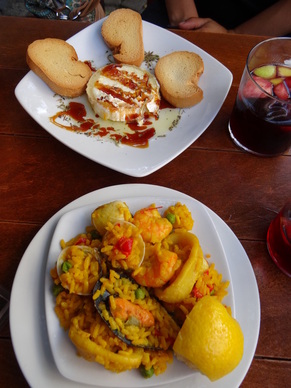 Paella, Baked Goat Cheese, and Sangria Our arrival in Seville (and into Spain) was immediately greeted by some of the best offerings of Spanish culture. As it was late at night, we found a cervezeria right outside of our pension that was serving ice cold “tinto di verano” (wine of the summer) and delicious tapas. We stumbled through the language barrier to get a plate of delicious Iberian ham (similar to prosciutto in texture and taste) topped with aged cheese and some delicious albondigas (meatballs in a savory sauce). The next day we continued this onslaught of delicious bites with little plates of saffron speckled paella, baked goat cheese covered in fresh marmalade, and salmorejo, a chilled tomato and bread soup topped with boiled egg and the aforementioned Iberian ham. What a welcome to Spain! As we started to explore the city of Seville and learn about the region of Andalusia, we found that it wasn’t only our taste buds that would be excited. The rich history of the region leaves plenty of eye candy for even the casual observer. It all starts with Southern Spain’s rich Islamic history. 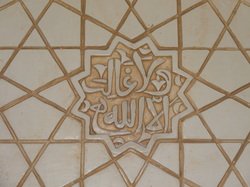 Arabesque Plasterwork In 711 A.D., Islamic leaders invaded the South of Spain (toppling the Visigoth empire that had temporarily ruled following the fall of Rome) and established the Kingdom of Al-Andalus, the root for the modern day territory of Andalusia. During their rule in Spain, the Islamic territories were a model of scientific research, artistic development, and religious tolerance (at least until 1100 or so). From the capital of Cordoba, the largest library in the world (at that time) was collected and massive investment went into the development of palaces and mosques, some of which still remain today. Islamic rule would continue strongly in the region until 1212, when North Catholic Kingdoms defeated most of the Muslim States established in Adalusia. The exception was the Nasrid Kingdom in Granada, which managed to last until 1492. 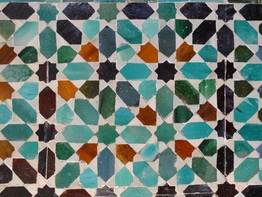 Azulejos - San Bartolome in Cordoba As we toured the palaces and mosques of Islamic Spain, we were awestruck by their use of simple substances like timber and plaster to create amazing décor in a style called arabesque. Imagine delicately carved plaster and carefully painted tiles (called azulejos) all coming together to form an endless interlacing of geometric forms. The Muslims believed that this stream of scrolling geometric patterns was an apt representation for eternity. Each piece is simple and beautiful in its own right, but when put into the context of hundreds of other pieces, the whole attains a beauty that the mind can barely begin to grasp. It’s a form of art that attempts to replicate how difficult it is for our finite minds to perceive something as vast and infinite as God. We started our tour of Moorish Spain with the Alcázar of Seville, a fortress turned palace largely built in 1364, after the fall of the region to the Catholic armies. However, it was largely crafted by Muslim craftsmen from Granada and retains a strong Islamic flair. Perhaps most memorable for us was the domed ceiling in the Ambassadors Hall consisting of carved and gilded interlaced wood (see picture above). From Seville we traveled to Granada, home of the most fascinating of the Islamic relics – the Alhambra. Consisting of an old fort, a palace, and some of the most stunning palatial gardens we have ever seen, the Alhambra is truly a sight to behold. It sits perched atop a hill overlooking Seville and our morning climb to get into the Nasraid Palace at the appointed time already had our hearts beating in anticipation (and exhaustion ;)). The Nasraid Palace is a wonderfully preserved example of the arabesque style and we had to hold our jaws in our hands as we gazed upon its beautiful courtyards, throne rooms, and the geometrically inspired ceilings. An early morning bus ride took us from Granada to the former Moorish capital of Cordoba where explored the Mezquita, a mosque originally built in 786 to establish Cordoba as the heart of Al-Andalusa. The Moors used bits and pieces of the Roman ruins around the city to create a “forest of arches” that creates much the same effect as the geometric patterns discussed above. It is like walking through eternity – at once both humbling but also inspiring. Unlike the impersonal experiences we often feel in cavernous and cold Christian cathedrals, the Moorish architecture brought an intimacy and aesthetic focus on the abstract that was very appealing for us. Perhaps by avoiding direct representation of the infinite (like a person or thing), it allows the mind to stay soft and open for whatever experience it may have of something so beyond comprehension. Unfortunately, the conquering Catholic royalty of northern Spain thought that it was necessary to tear down many of these mosques and build churches directly on top of them to express the domination of Christianity over Islam. In the case of the Mezquita, it was so large that the new rulers settled for putting an entire Cathedral in the middle of the Mosque. It is a very strange thing to see the Cathedral sitting there in the middle of the vast building. For the best illustration of it, see this video. 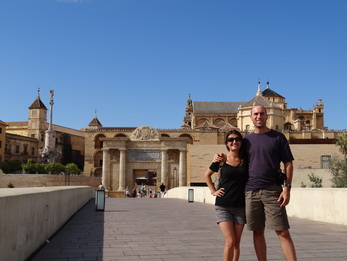 On the Roman Bridge leading to Cordoba For the Jews in Spain (known as Sephardic Jews), their fortunes changed with each conqueror. Jews were treated very poorly by the Visigoth’s who took over from the Romans, being forced to convert or leave the continent under their rule. When the first conquerors of Al-Andalus arrived, many Jews sided with them to get relief from the oppression. They were welcomed into Muslim society as dhimmis (non-Muslim members of monotheistic faiths). Their mastery of Arabic allowed for a golden age in which Jews held high positions in diplomacy, medicine, commerce, and agriculture. But as time went on, more conservative Muslim factions such as the Almohads took over Muslim Spain and Jews were forced to either convert or flee. Ironically, many did flee to the northern Catholic Kingdoms, who treated them well while they were needed to stabilize the government during the Reconquista (the battle by Christian royalty to retake Spain from the Muslims). But soon things would turn for the worse for Jews in Spain, as we’ll see when the blog post continues in Madrid and Toledo. For now we leave you with this link to all the wonderful pictures of Andalusia, as well as a mouthwatering picture of that delicious Salmorejo! We're headed to Portugal next!
For the Iberian Peninsula, our story will start at the end of the journey rather than the beginning. Neda and I were sitting at a café in Barcelona at the end of a long travel leg that had taken us through Hungary, Croatia, Slovenia, Italy, Portugal and Spain over two months. The hotel refused to offer the luggage service they claim on their website, so we took our bags to the Barcelona History Museum where we saw the underground ruins of the 2,000 year old town of Barcino before settling into a café near Las Ramblas to have a bite to eat before taking the train to the airport. 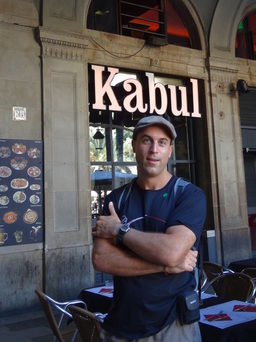 The scene of the crimes 10 years ago I was wary of being near Las Ramblas with our packs as this was the scene of the most traumatic travel experiences during my last trip through Europe ten years ago. At that time, I had my wallet stolen on the subway while my traveling companion had his camera stolen in a nearby hostel (pictured to the left) and I think another friend had theirs stolen on Las Ramblas. But we tucked our two backpacks close to our seats on the side away from the street and settled into some gazpacho and a ham and cheese baguette. At one point, the owner of the restaurant came by and said something to us in Spanish, pointing to our packs and then his eyes – reiterating the point of watching our packs. Why we didn’t secure the straps of our bags under the table, I don’t know, but we would soon pay the price. One of the roaming hoods we had seen around the restaurant, wearing a bright pink and blue collared shirt with red splotches all over his face, tapped me on the back and asked me some incomprehensible question in Spanish. I answered that I didn’t understand and then turned to Neda and asked if she had understood. She said no, and we continued eating while I patted my wallet and passport as my wariness increased. Then, one of the Englishmen sitting at the table piped up, “Hey there, I saw a hand near your rucksack there…”. 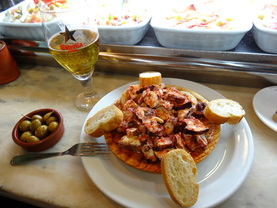 Octopus Tapas My eyes flashed over to our packs and sure enough, my black pack, with all of our electronics inside, was gone. I only had time for one “Jesus babe!”, before trouncing out of my seat and down the street. I didn’t know who had taken our packs, but it was clear that the guy in the neon pink and blue shirt was the “distraction man”. The pack was already out of sight, but I caught sight of the distraction man about 150 meters down the street, walking briskly away from us to avert suspicion. He was the last link to the bag that I had. If he got away, it was over. He was too far away to call for help – no one would understand what I was saying from that far and he could easily get away if he turned quickly and lost me. At this point, he had the advantage of distance and knowledge of the city. But I had several advantages of my own. Firstly, we had bargained for a later checkout that morning and taken the time to do yoga for the first time in weeks – leaving me warmed up, stretched out, and primed for running. Secondly, I was wearing my trusty Clark walking shoes and not my loose fitting sandals that were ill suited for running. Thirdly, I was mad as hell. I took off in a dead sprint, my knees pumping high in the air, people whizzing past me in a blur. Neda started running as well, but she hadn't had her sandals on at the time it happened and with her smaller barefoot strides she was quickly left behind. I saw the distance between us shortening to maybe 75 meters before the thief turned around and saw this Jew out of hell barreling towards him. He broke into a run and quickly cut to the right, out of my sight. But I was close enough to see where he had turned and banked after him. I found myself crossing a rounded stone arch through an empty courtyard with the thief just exiting at the other side. I was in time to see him bank left as I dashed through the courtyard, while my brain started to fully comprehend what was at stake. That bag was worth thousands of dollars to us, far more than the purely raw materials it contained. I ran faster. 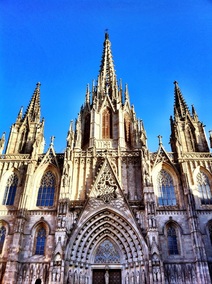 Barcelona Cathedral Once through the opposite gate I turned and was faced with two directions – straight ahead to the west or a turn right to the north. The thief wasn't in sight. Luckily, some old ladies walking down the street probably guessed what was happening and pointed me north, allowing me to lose little time in my pursuit. I sprinted up the alley to which they had pointed and came out to an isolated three way piazza with no sign of the distraction man. My heart was pumping and my legs were burning from the lactic acid that the sprint had produced. Each street of the intersection continued along for at least 50 meters without any turns – where could he have gone? How good of shape was the thief in? I had seen him slowing even through the courtyard and was sure I could catch up – unless he had some unseen doorway in which he could disappear? The piazza was part of the old city of Barcelona with two and three story stone apartments silently observing my desperation. My eyes caught site of a dumpster in the northern corner and I ran over to inspect. Sure enough, the thief was huddled behind the dumpster trying desperately not to slow his panting. Too late. I grabbed him and raised my fist, but he slipped out of my one handed grasp and ran down the street. But it was over for him. Now I knew he had no weapon and I easily followed his tired gait, intending a football tackle to pin him down and find out the whereabouts of my bag. 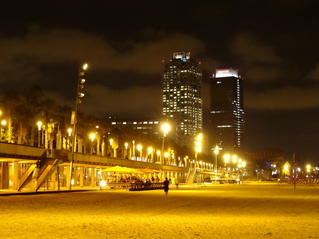 A latenight stroll on the beach A bit of luck prevented the need for any violence. As he ran away from me, he chose a street with 10 or 15 people walking in on our direction. I shouted for help telling everyone he had stolen my bag. A burly Australian (originally from El Salvador) was the first to answer my call, stepping in front of the greasy thief and prodding him backwards with his chest. Another man on a bicycle dismounted on the other side and we had him surrounded in a closing triangle. As I menacingly approached, demanding the bag, he fumbled for his pockets, pleading for a moment to call his fellow bandits. I asked the guys to call the police regardless, but while they had their phones out pretending to dial, to my dismay I later found out that neither of them had the number to call! The thief made his call and led us up a nearby street where one of his outfit was waiting, but without my bag. Then I turned around and there, walking up the street leisurely with a grey collared shirt, a man approached with my bag on his back. A surge of relief went through me as I ran over to the man and stripped the bag off of him. With the bag in hand and police nowhere to be found, the thieves slipped away as I turned to thank those who had come to my aid. The Australian’s girlfriend had walked along with us at a distance as well and they walked with me as I tried to find my way back to Neda. I was worried that she had run off – leaving her bag unattended and open to a possible double theft. While we walked, I found out the couple’s name – Walter and Simona and was in for a quite a surprise when I found out that Simona was from Stara Zagora – the town where we live (and Neda is from) in Bulgaria! It felt great to see a Bulgarian in this town full of madness and they were kind enough to walk all the way back to the café with me, where we found Neda (with her shoes this time) heading up the street in search of us. Neda described her amazement when she saw me strolling back down the street with the black straps of my bag secured snugly around my shoulders. Against the odds – we had successfully run with the thieves in Barcelona! I named the post after the famous “Running with the Bulls” in Pamplona Spain because it reminded me of a passage I had recently read in Pema Chödrön’s “When Things Fall Apart – Heart Advice for Difficult Times” about the eight worldly dharmas – or pairs of opposites that hook us (like the horns of the bulls in Pamplona) into either pursuing them or trying to avoid them. These pairs are pleasure and pain, gain and loss, fame and disgrace, and praise and blame. When we respond to them in our normal conditioned ways, we strengthen our false sense of self while creating distance from the world around us. Chödrön writes: “We might feel that somehow we should try to eradicate these feelings…A more practical approach would be to get to know them, see how they hook us, see how they color our perception of reality, see how they aren’t all that solid. Then the eight worldly dharmas become the means for growing wiser as well as kinder and more content… When we become more insightful and compassionate about how we ourselves get hooked, we spontaneously feel more tenderness for the human race. Knowing our own confusion, we’re more willing and able to get our hands dirty and try to alleviate the confusion of others. If we don’t look into hope and fear, seeing a thought arise, see the chain reaction that follows – if we don’t train in sitting with that energy without getting snared by the drama, then we’re always going to be afraid. The world we live in, the people we meet, the animals emerging from doorways – everything will become increasingly threatening.” 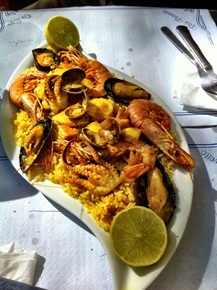 Paella! Our encounter with the thieves in Barcelona could lead us two ways. If we get hooked by the horns of fear, loss, and blame then we begin to hate the thieves, hate the city that spawned them, and close ourselves off to a world that is full of injustice, greed, and the pain that fuels them. If we just sit as the bull charges, watching the horns with curiosity and openness – then before the horns find our flesh, a tenderness towards our assailants arises that deflects the blow. Of course the thoughts of anger will arise, but if we watch them instead of following them, those thoughts become our guides towards contentment rather than our tormentors of continually re-hashed negative stories. I’ve spent 6 days total in Barcelona and have been robbed twice – the only two times in my life in fact. Despite the wonderful Gaudi architecture, charming old city, and lively people, Barcelona seems to always present challenges to the illusion of security and stability that I find myself walking around with most of the time in life. And for this gift, I bow graciously to the city – even if I won’t be returning anytime real soon :). As I mentioned, this post is out of chronological order. We are in Bulgaria now and I will be posting the rest of Spain and Portugal in their proper order: Andalusia followed by Portugal, followed by Madrid and environs. Barcelona was our last stop, but this story was fresh and had to be told! To see the pics of our time in Barcelona, click on this link:
Heading south from the Bay of Naples and the Amalfi Coast we trained down to the largest island of the Mediterranean Sea – the infamous Sicily. Sicily is a fascinating blend of cultures, which has at various times been ruled by Phoenicians, Greeks, Romans, Arabs, Normans, Spaniards, and the French. This gives it a complexity of character that we would discover was much different from mainland Italy. At the crossing from the mainland, the train disconnects and boards the underbelly of a giant ferry before unloading on the other side! In a hostel in Palermo we were talking to some younger travelers, one of whom had fallen asleep during that part of the trip. He asked us, “how did we get across to Sicily? Someone told me there was a massive bridge across.” We all had a good laugh, though frankly before the crossing I didn’t realize that trains could just roll onto ferries so easily! Our first stop off the train was in the volatile city of Catania. Nestled at the bottom of the tallest volcano in Europe and one of the most active in the world, Mt. Etna, Catania seems to derive its frenetic energy from the liquid fire that occasionally shoots into its skies. Pulling into town also brought back fond memories of one of my favorite shows growing up, The Golden Girls! Sophia is from Sicily and would often tell stories about Mount Etna and its eruptions. It’s funny that coming into the home of the Mafia you would think I would have the “Godfather” more on my mind, but instead I kept thinking of Sophia! 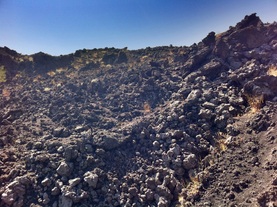 Etna Lunar Landscapes While in Catania, we marveled at how much of the town was built from the igneous rock that spurts forth from Etna every few years. In 1669, the eruptions were so severe that magma wiped out a large part of the city. Citizens then took the cooled magma and incorporated it into their city – the cobblestones on the streets and blocks of their buildings. We took a tour of the region around Etna, gaping at the 3300 meter high volcano while walking around the lunar landscape of hundreds of craters that have formed from eruptions over the years. We walked through tunnels created by the lava flow and learned about how the people of Catania cope with this looming threat over their homes by fully embracing it. The Catanians recognize that Etna is a danger to them at any moment, but they also appreciate the incredibly fertile soil that she provides and the mortar she produces from which they can build. We found it inspiring how they bring forth fertility from such destruction. A product of that fertility is the delicious wine they produce in the region from the Nerello Mascalese, Nerello Cappuccio and Nero d'Avola varietals. Another delicacy is the sweet eggplant, used to make dishes like “Penne alla Norma,” or penne with tomato sauce, eggplant, and salted ricotta cheese. 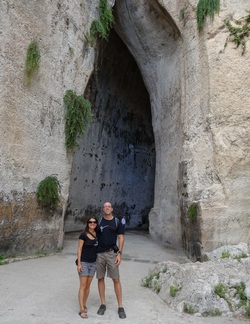 The Ear of Dionysius From Catania we headed south to Syracuse, one of the strongest cities of Ancient Greece and a competitor with Athens during that time. We spent just one night exploring the ancient ruins of the Greek city slightly outside of the town as well as in the small island of Ortygia, where the ancient city has been built over by generations of successive conquerors. Outside the city lies a beautifully preserved Greek theater, where the famous playwright Aeschylus is said to have premiered some of his tragedies. There is also an old stone quarry of the ancient town, which was used as a prison. It is famously called the “Ear of Dionysius” because the tyrant king is said to have listened to his prisoners speak from above via the chamber's well tuned acoustics. But perhaps the most interesting part of the city for us lay in the city’s Jewish history. In 1492, when Isabelle and Ferdinand completed the reconquest of Spain from the Moors, they also decided to expel all Jews from Spanish territory (which Sicily was at the time). A that point, the Jews had been a vibrant part of Syracuse’s history for nearly 1000 years so their forced removal was a gross injustice, albeit only the final one in the history of the Jews in Sicily (read more Jewish history in Sicily via the preceding link). 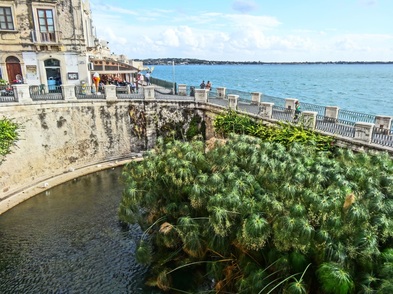 The Fountain of Arethusa overgrowing with papyrus plants Fast forward to 1994, nearly 500 years later, when the foundation of a building was being renovated to be made into a hotel in Syracuse. While digging, workers uncovered the remains of a mikvah, or ritual Jewish bath 18 meters below the ground that dated from at least 600 AD. When fleeing the city, the Jews had buried the mikvah (it took 5 truckloads of dirt to dig it out), most likely to prevent sacrilege from occurring there and in hopes of one day returning. The mikvah, believed to be the oldest in all of Europe, was used for ritual baths by both Jewish men and women. For women, they would fully immerse themselves after certain occasions like end of a menstrual cycle, after giving birth, and before marriage. The men would use it to clean themselves in preparation for the Sabbath. On an island surrounded by salt water, the Jews found an old Greek well that was fed by a freshwater spring to which to connect the mikvah so that within 24 hours all the water from a ritual bathing would be fully replaced by fresh water. It is believed that this underwater spring may also feed the famous Fountain of Arethusa located nearby on the island. It was amazing to learn how the entire mikvah chamber had been carved only with a hammer and a chisel, a remarkable achievement for the time. For us it showed the Jewish people’s dedication to this sacred place and also the connection to the land that we had also noticed in the people of Catania. Click here to read more about the mikvah. 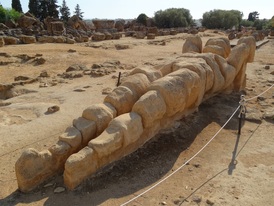 The telamons From Syracuse we stopped for a night in Lentini to meet up with Lucio, a gracious Couchsurfing host who made us a homemade Sicilian meal and told us stories of the life in Sicily. Then we headed west to Agrigento, where more Greek ruins awaited in the stunning Valley of the Temples. The valley houses the remains of 5 Greek temples built along the ridgeline of the island to honor the Gods and greet homecoming sailors. The most preserved Temple of Concordia dating from the 5th century BC shoots one back in time to when Agrigento was a prosperous city-state engaged in trade and continuous war with the regions surrounding it. The more ruined Temple of Hercules measures about the size of the Parthenon in Athens while the completely destroyed temple of Jupiter would have been even larger! That temple featured giant “telamons” between its Doric columns which held up the ceiling of the enormous temple. In the town of Agrigento itself, which sits high above the valley, we enjoyed climbing through its winding streets and sampling some fresh Sicilian treats (including a very unique pistachio cous cous) from the nuns at the Monastero Santa Spirito. 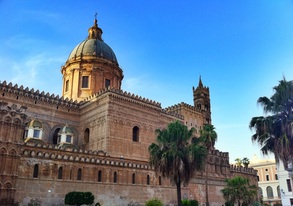 The Cathedral in Palermo We traveled north by train from Agrigento to Palermo, capital city of Sicily and fictional home of Sophia. Palermo is a fascinating city because it still retains traces of its Arabic heritage in addition to its Greek, Roman, and Norman influences. Palermo was an Arab city from 827 to 1071, after which the Normans managed to conquer it back and make it a part of the Byzantine Empire. We found the Cappella Palatina there to be a foreshadowing of our trip through Southern Spain with its heavy Arab Influence. Cappella Palatina, housed within the Norman Palaces built after the conquest (Palazzo dei Normanni) is a perhaps the most stunning mixture of Arab, Norman, and Byzantine art in the world. It combines beautiful golden Byzantine mosaics with muqarnas (Arabic style) ceilings and Norman doorways. The Norman Palaces were a snapshot of the opulence enjoyed by the ruling families of Sicily over the years. But the most infamous ruling families in Palermo are still very much present, though their power may be waning. The Mafia was born out of Sicily’s transition from feudalism to private landownership. When Italy annexed Sicily in 1860 it redistributed much of the land to private landowners, but newly formed authorities didn’t have the manpower or experience to enforce property rights and protect property from bandits. Thus were born the first mafia clans. The necessary evil of “protection” would later become a lucrative racket where local merchants had to pay for the protection of their businesses or suffer from the very people they refused to pay. We were surprised to learn from locals that 70% or more of the businesses in Palermo still pay for this protection – proof that the perception of the waning power of the mafia in the area may be fictitious. Luckily, we didn’t have any run-ins with the mafia other than the stories about protection that the locals told us. When we asked one local what happened if you don’t pay protection he said, “first you just get wax or glue in the keyhole of your door. That is your first warning. If you don’t pay after that some accident will happen to your business – a fire or a burglary perhaps.” Makes small business in America seem a lot simpler, huh? 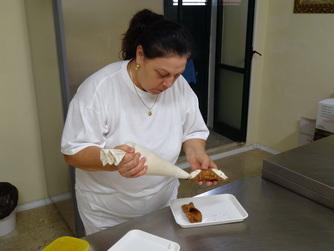 Fresh cannoli! Other than talking mafia and visiting churches we spent our time in Palermo doing what we enjoy the most – searching for the local dishes. We went on a persistent hunt through the Mercato di Ballaro looking for the “Fabrica di Cannoli,” a family owned cannoli kitchen that supplies many restaurants with their cannoli. They have a small kitchen where you can get individual orders of the delicious desert and watch the freshly made ricotta and chocolate mix squirt into the fried cannoli shell. It’s like a delicious bite of heart attack! Neda also started to fall in love with eggplant as we enjoyed eggplant parmigiana and numerous other preparations of the nightshade. We ended our stay with a tasting of the local pasta con sarde, which is spaghetti with minced sardines, fennel, pine nuts, and raisins. Certainly one of the most interesting pasta dishes we had, though not at the top of our list to try again! All in all, Sicily was a experiences in extremes. Noisy streets and even nosier people. Flavorful foods and wines and enough history to leave even the biggest buff bewildered. We loved our time there, but it was time to say goodbye to Sophia’s home and board the plane from Palermo to Seville to start our Andalusian explorations! A final quote to leave you with:
Rose: Did you know they have an egg named after you Blanche? Blanche: Oh really? How is it prepared? Sophia: Over easy. To see all the pics of Catania and Syracuse, click here: To see all the pics of Agrigento and Palermo, click here: My sister, in her blog Live Love Laugh, wrote about the phrase Carpe Diem from the perspective of a woman who has undergone great tragedy but uses this philosophy as a way to embrace life rather than withdraw from it. As we traveled South of Rome with Neda’s family (they joined us there for a little backpacking family vacation) to Naples and the Amalfi Coast, Carpe Diem became not just a philosophy, but a historical signpost painted over every attraction we visited. 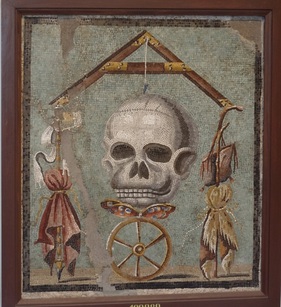 An ominous mural from Pompeii First up was bustling Naples, which with its dirty alleyways connected by interwoven laundry lines was a bit reminiscent of Southeast Asia. The old town’s buildings tower over you as you walk along narrow streets, and the variety of people and noises thrum like the oceans waves. Our main purpose in town was two-fold – eat as much pizza as possible (Naples is the home of pizza!) and visit the Museo Archeologico Nazionale di Napoli, where the treasures of nearby Pompeii and Herculaneum now reside. Both towns were covered under volcanic debris with the explosion of nearby Mount Vesuvius in 79 AD and after being discovered and excavated, stand as some of the best preserved examples of Roman architecture and art available to us today. In the museum, wonderfully vivid murals, sculptures, and paintings have been preserved from the two cities – depicting the mythological, sexual, and everyday art of which the people of Rome adorned their homes and temples. My sister’s philosophy rang through the halls as I imagined the people huddling for shelter while volcanic mud claimed their lives and embedded them into our imagination 2000 years later.  A recent pic of our lady On the pizza front, we ate at “Brandi Pizzeria” the first pizzeria in the world and home of the traditional pizza margherita, which was created in 1889 when the chef of Brandi created a pizza with tomato, mozzarella cheese, and basil for the visit of Queen Margherita di Savoia. Meant to represent the Italian flag with its ingredients, this was the first time cheese was added to this flat bread, transforming it into one of the most popular foods in modern history. Today, the pizza chefs at Brandi are still slinging delicious pies as we found out in person. Though it must be said that for us there is only one Brandy truly in our lives – we miss you little one! It was a thoroughly successful day in Naples, and was followed the next day by a trip to the ancient ruined cities in person where we walked the streets that bustled with life prior to the eruption. Herculaneum is smaller and better preserved than Pompeii, making it a favorite with its ruined bathhouses, villas, and food shops while Pompeii offers a glimpse of the vast destruction caused by Vesuvius. 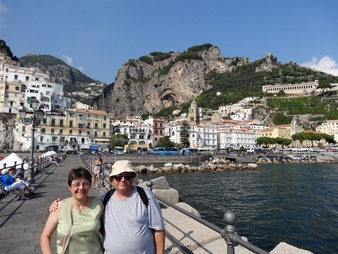 Nadia and Petko at Amalfi From Pompeii we traveled around the bay of Naples to station ourselves in Sorrento for the exploration of the Amalfi Coast. The coast is named after the maritime empire of the city of Amalfi that once dominated the area. But “Carpe Diem” would linger in our minds when we learned that most of the city, with its population of 70,000 souls, slid into the sea along the steep cliffs of the coastline during an earthquake and ensuring tsunami in 1343. The theme resonated even deeper in our brains as we tottered and swerved along the coastal road on the public bus to get to Positano and Amalfi, only a meter or so away from the steep cliffs that claimed the city hundreds of years before. Today both Positato and Amalfi sit along the coast in defiance of their location, beautiful cities carved upward from the edge of the cliffs into the hills above. We enjoyed perusing the art galleries and letting our eyes water at the prices of food and drink before returning back the way we came on an overcrowded bus trip that afforded beautiful views of the setting sun. 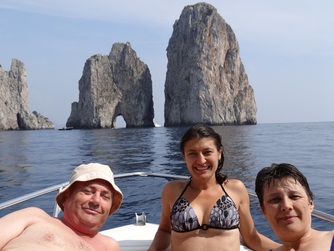 Finally, we headed to the Island of Capri, fabled location of Emperor Tiberius’ summer home and popular jet-setting destination. We rented a “motorized dinghy” to get the real tour of the island and spent four hours gaping at the island’s sheer rock walls lifting out of the sea, snorkeling at the green and white grottos, and sailing through the arched gap in the Faraglione di Mezzo with our little dinghy. As we rounded the island, we could see the fabled Tiberius’ Leap, where legend has it the emperor would have undesired guests and disobedient servants thrown. Near the end of the ride, as we crossed the wake of a giant ferry, we felt like one of Tiberus’ guests and said a final Carpe Diem as the bow of boat lurched upward to the sky before finally settling back safely into the frothy sea. Seeing the precariousness of life over history in the Bay of Naples region beckons one to find appreciation in whatever moments we have on this globe. On this part of the trip we found that appreciation in the time spent with family and the beauty of Italy’s coast. I still hope each day that my sister and her husband continue to find it as they struggle to seize the day in the midst of a tragedy just as world ending as any volcanic eruption or earthquake could ever be.
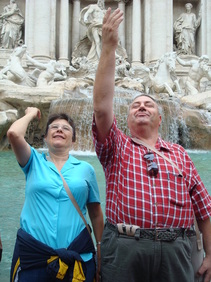 "We'll return to Rome!" On the morning of September 4th, the Bulgarian clan descended upon Rome like Hannibal, with his famed elephants, never could. Petko and Nadia (Neda’s parents) flew in from Bulgaria and Dimitre (Neda’s brother) took the long haul from Boston while we arrived early on the night train from Venice. Our spacious apartment gave us ample space to unwind before beginning a whirlwind tour of Rome’s sites – the Vatican Museum, Sistine Chapel and Saint Peter’s Basilica on one day, the Pantheon, Spanish Steps, Trevi Fountain, and Piazza Navona another, and the ancient Rome of Palatine Hill, the Forum, and the Coliseum on the last day. It was the first time this part of our family had ever visited Western Europe and the first time in our trip of the world that we have been joined by family. Italy is a great place for such a meeting, as the wonderful cuisine and multi-course meals provide time to catch up and enjoy the company. I’ll skip description of the common tourist attractions above because there is already so much information about them available online or in books (though I will pepper in some pictures of them below). But one slightly lesser known attraction turned out to be my favorite and was tremendously fitting to visit with a family of Bulgarians! 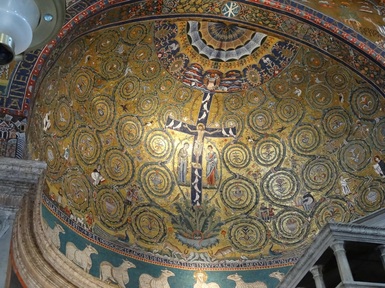 The Tree of Life San Clemente Church sits about a half of a kilometer from the Coliseum and at first glance, it appears to be another beautiful 12-13th century building in Rome. Its central nave features a golden fresco of Christ connected to a “Tree of Life”, a winding network of vines that demonstrates the interconnectedness of life. This is the first clue that this church is a bit different from others, as such an explicitly eastern theme rarely occurs in the churches we've seen so far. But the real beauty and intrigue of San Clemente lies beneath it. It is here that a 4th century church has been preserved in the catacombs of the newer church. This original San Clemente church is haunting to walk through as its LCD lit rooms provide just enough light to imagine worshipers here over 1500 years ago. 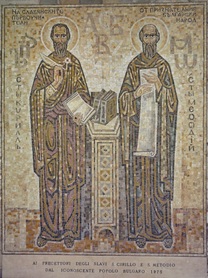 Cyril and Methodius For us the main attraction lay in one of the side naves of this ancient building. It is here that Saint Cyril is buried. Cyril, along with his brother Methodius, created the foundation of the Bulgarian written language, called Glagolitic. Cyril had been in Rome to argue that the church liturgy should be spoken in Glagolitic so that the natives of the Slavic regions could understand it. This was opposed by the German clergy, who had used Latin in the region to maintain their position. Cyril convinced the pope that Glagolitic should be allowed, but died shortly after. The Pope wouldn’t let him be returned to his home so his brother asked that he be buried at San Clemente church (whose body the brothers had returned to the Vatican just a year earlier from the Black Sea). Cyril’s tomb was surrounded by tablets inscribed with messages from the nations and peoples he had influenced. There were tablets from the Serbians, Ukrainians, Russians, Slovenians, & Croatians. The Bulgarians had sent a beautiful mosaic of the two Saints to sit opposite the tomb, in honor of the language that Cyril and his brother had given written form. Bulgarians hold a special regard for the Cyrillic alphabet, as it was fully refined from the Glagolitic alphabet Cyril and Methodus had created by their students under the sponsorship of Kings Boris and Simeon during the 1st Bulgarian Empire. It was touching to see all the nations that had honored this man who had helped create a common written bond between them. Much like the Christ depicted in the church above, Cyril’s tomb was a testament to interconnection. 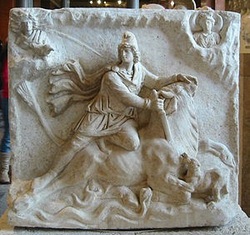 Mithras slaying the bull For most visitors to San Clemente, the interesting part of the visit is not just the 2nd church that lies beneath, but the even older archeological area beneath the 2nd church! It is here that archaeologists have discovered the best preserved “mithraea” (underground temple of the religion of Mithraism) in the world. Very popular among Roman soldiers between the 1st and 4th centuries, the Mysteries of Mithras revolved around the story of the God Mithras slaying a wild bull for the God of the Sun. As the bull dies, its blood gives life to the ground around it. Initiates would eat bread and water to represent the body and blood of the bull and the life it gives out of its death. Citied as an early competitor with Christianity, Mithraism shared many of the same rituals before being systematically destroyed by the early Christian Church. That is why many mithraea have been found with Church’s built on top – a symbolic representation of Christian domination over its competitor. With ancient religions lying beneath the foundations of the Bulgarian ancestral language, Rome proved to be a penetrating historical experience for all of us. From there, we would head down to an equally interesting region of Italy – the Bay of Naples, where ruined cities and the ghosts of the past waited.
To see all the pics of Rome, some of which were taken on Jeff's new Sony Cyber-shot DSC-HX30V camera, which includes GPS tracking of our shots, click here! 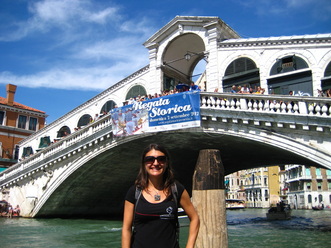 The Rialto over the Grand Canal With Slovenia and Croatia so heavily influenced by the power of the Venetian Maritime Empire of the middle ages, we felt it a natural next stop as we headed into Italy. Venice was bustling during our weekend there with two big events occurring – the Regatta Storica and the Venice Film Festival. Our first night in town we marveled at the city’s interwoven web of bridges connecting the 170 islands that make up Venice proper. Crossing from island to island so seamlessly over intricately carved arched bridges is a reminder of the architectural genius that was required to turn this swampy marshland into one of the most powerful and beautiful cities in history. As we wandered along, we serendipitously came across Piazza San Campo, where we saw a line of people waiting for tickets to a showing of the film festival. Our timing was perfect and we snagged two tickets to “At Any Price” starring Zach Efron, Dennis Quaid, and Heather Grahm (we missed the premier the stars attended by only a day!). After enjoying a quick bite of our first “pasta fresca” (homemade fresh pasta, which in comparison to typical package pasta in America is wonderfully firm and flavorful), we headed to the movie, which was showing on a giant screen right in the middle of the piazza. The film is a compelling drama revolving around the plight of the small American farmer as he sacrifices his values to an “expand or die” mentality and becomes increasily boxed in by the ominous reach of Monsanto’s GMO seeds. These genetically modified seeds are patented by Monsanto and require farmers to buy entirely new seeds each year rather than clean and re-plant the seeds as they have been doing for centuries. The movie also features heavy doses of American iconography, with Nascar, the National Anthem, and loads of shots of Iowa cornfields. The result was that I ended up feeling closer to America than I had since leaving over a year ago. What a strange feeling to have while sitting in the middle of a 500 year old piazza in Venice! 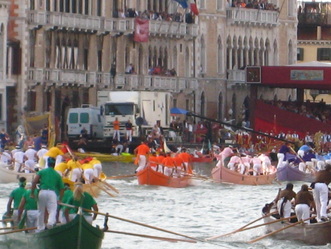 The Regatta Storica The rest of our time in the city involved lots of walking as we explored the city’s circuitous routes. We caught a bit of the Regatta Storica on the main canal as thousands of Venetians donned traditional garb and raced their boats and gondolas along the canal in a tradition harkening back to Venice’s days of maritime glory. We gaped at the amazing Piazza San Marco where the enormous bell tower occludes the sky and the gorgeous church gleams golden in the sun. We also struggled a bit to find good restaurants in this town whose daily count of tourists outnumbers residents! With copious copertos (a charge for sitting down which seems to get you nothing but some stale bread) we bounced like ping pong balls through the streets looking for a decent place to eat. By the end, we were ready to hop on our nighttrain and get down to Rome to meet the family, but we were happy to have gotten to experience some charm and Romance in Venice.
Dreams have always intrigued me and leave me wondering if they have a deeper meaning. Does the brain weave nets of subconscious thoughts that can only be unraveled in the middle of the night? I remember my dreams often, more often than most people I know. And in nearly all the dreams I remember I am running. Running from something, from anything. Sometimes, I am running from aliens or from Roman soldiers, through woods or between canyon walls. Usually, the colors are so vivid and the dreams so engrossing, that I awake panting and looking around - only to find my bedroom and Jeff sleeping peacefully at my side. 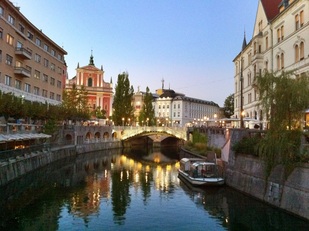 Beautiful three bridges in Ljubljana But something changed in Slovenia! For the first time in my life, a different kind of dream was revealed to me. In this plot, I was a detective and was determined to catch a serial killer. Finally, the tables were turned and instead of running away from a killer, I was running after one to stop another murder from happening. This feeling of empowerment in the dream caused a rush of relief to wash over me as I awoke that morning. I felt like the dream was a prophesying a time when I would have the opportunity to turn the tables on my fear. Or was the dream simply an affirmation of the many fears I have already shed during this travel time? 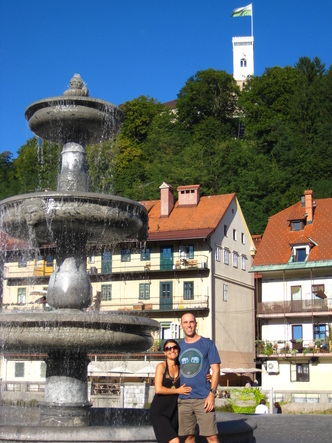 The central plaza with the castle in the background Slovenia, much of which is nestled in the Julian Alps, brought some of the most beautiful mountain scenery we have encountered thus far. We started in the capital city of Ljubljana, a lovely town towered over by its beautifully restored castle. Ljubljana is one of the smallest capitals in Europe and doesn’t have any major ‘attractions,’ which makes it great for strolling the streets while scoping out gelaterias and sweet shops. The charm of the city is largely attributed to Jože Plečnik, who largely rebuilt the city’s waterfront and key civic buildings after an earthquake in 1895 left the city an open palette. His playful and seducing architectural buildings and bridges give the city a feel of enchantment that is augmented by the stunning views we enjoyed from the castle. For pictures from Ljubljiana, click here - http://flic.kr/s/aHsjBT2hNS. After some time in the city, we were ready for nature and moved on to Lake Bled, our base for exploring the Julian Alps. Lake Bled may be one of the cutest little towns in Europe! The homes looked so idyllic they could have come straight from a movie and they all surround this gorgeous glacial lake that was formed when the Bohinj Glacier melted after the last Ice Age. Even more romantically beautiful, the receding glacial waters left a tiny little island in the middle of the lake. It now holds the Church of the Assumption, a 17th century baroque church, though excavations have found remains of a Slavic cemetery and a pre-Romanesque chapel. The island was considered a place of great importance to the local Slavic tribes who lived here before Christianity. They so fiercely defended this little island that the Romans could never overtake the area, despite it being right next door to modern day Italy! With the Julian Alps as the backdrop to this picturesque lake and its little island, the view from the Mala Osojnica viewpoint (which we climbed at a breakneck pace to beat the sunset) was breathtaking! 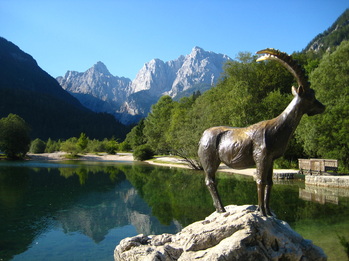 The Goldhorn at the entrance to Triglav Our second day was a small tour full of adventures all throughout the park, which takes up about a third of the country. The jagged ridges of the mountains are dramatic against the blue sky, and always look like they are covered in snow due to the crumbling rock atop. The symbol of the locals is the Goldhorn, a type of buck, who is highly respected in this area. It lives at the highest peaks of these mountains and the end of its horns really shine as if they were gold. Ancient myth says that at one point Triglav park was a paradise of greenery and soft hills where humans and magical creatures lived in harmony. Ruling over it all was an immortal white Goldhorn. During this time, three mountain ferries known for their fortune telling abilities had a vision after a local boy was born in the mountains. The fairies saw that the boy would one day kill the Goldhorn for his gold and ruin the paradise they all enjoyed. Two of the fairies refused to speak of the vision, but the third fairy voiced this prophecy and was cursed by her two sisters for doing so. She was turned to stone by the curse and it is said that you can still see her petrified face edged in the mountain stone. 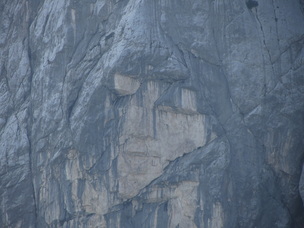 The Petrified Fairy, Julian Alps In the end, the prophesized boy grew up and fell in love with a beautiful Slovenian girl who had also caught the eye of wealthy Venetian merchant. The merchant showered her with expensive gifts that the pour hunter boy could never match. So he decided that only by killing the Goldhorn and collecting his golden horns could he compete with the merchant and win over her love. After an epic three day chase, they met on a ridge where both man and beast stood facing each other. The boy shot at the Goldhorn and his aim was true. The arrow pierced the beasts neck and blood started to gush onto the ground. But to the boys surprise, where the blood hit the ground, beautiful white alpine roses immediately sprung up and blossomed. The Goldhorn ate the flowers and his wound immediately sealed up and healed. In a rage now, the Goldhorn charged the boy, who tried another arrow but missed as he was blinded by the reflection of the oncoming horns. He took the charge straight on and tumbled down the hills to his death. The prophecy was broken. But so was the Goldhorn’s faith in humanity. The immortal beast was made with rage and disappointment as he ran across the planes, thrashing them into the jutting mountain peaks we see today. Nobody has seen the Goldhorn ever since, but locals say the tale cautions us to respect both the power of nature and also its fragility to human greed. 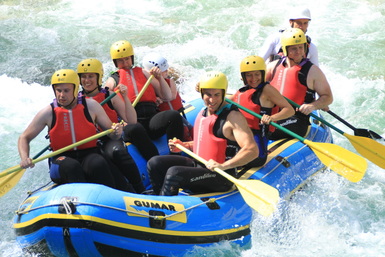 Rafting the soca The next part of our tour took us on a rafting adventure down the Soca River, or Emerald River, as the locals call it. The river is bright turquoise green and its crystal clear water is full of the rare species of trout, called marble, who can grow to be over a meter long! It is mesmerizing to look into the water and chilling when you jump in! Though the river was relatively low due to the drought this summer, the guides still made the trip lots of fun by setting up water slides with the rafts and offering us some optional challenges. Here is where my own dream (or prophecy?) comes into play. One of the stops of the trip was a huge, 8 meter (due to the low level of the river) high rock, edged into a deep pool of emerald water. The guide warned us that the jump looks much higher once you’re up there and that there is no easy turning once you go up. I hesitated for a moment as no other girls even attempted to climb the rock. But then I thought of my dream and scaled the stone. First up, Jeff jumped into the water with little hesitation, though he admitted that it was quite scary for him too! As the 2nd to go, when I reached the ledge of the rock, I found myself frozen in fear, especially since one of my biggest fears is of heights! We have climbed many waterfalls, mountain tops, and tall buildings through these travels, and with each journey I can feel a little bit of my fear melting away. But I have to say, jumping 8 meters into a foreboding flowing river is a whole another different story! After much coercing by the guide and encouragement from the crowd, I finally gathered the courage and jumped. Unfortunately, there was a photographer documenting our whole river trip (pics here) and he caught a really good picture of me on the way down. I didn’t know that my face could contort to this position! In this land of prophecies I was happy that my own came true. As in my dreams, I had overcome my fears and become the hero of my story instead of the victim. We finished our time in Bled by renting a row boat and visiting the little island. Rain forced us to act quickly and Jeff to row like a madman to get back to the mainland. We took this opportunity to relax and enjoy an afternoon in our little apartment as we prepare to cross into Italy with a stop in Venice en route to Rome to meet my family! For pics from Triglav and Bled, click here - http://flic.kr/s/aHsjBSZJ1s.
The following story will resonate with some of you more than others. Flying out of the London airport a few weeks back, I walked by a store that had the new Kindle Touch for 99 GBP(about $155), less than I remembered seeing advertised on the UK Amazon site. I had been thinking about getting an e-reader for our travels so I decided to just go ahead and buy it without the usual research...a rare act of shopping spontaneity on my part! But that night, once we had internet again, I checked the US Amazon site and found that the Kindle (with some unobtrusive advertisements) could be had for only $99. I immediately had buyer’s remorse and thought that maybe I should just carry the kindle in its packaging until we flew out of Dublin, where another of the same store would let me return it. So I went through the arguments in my head. By having the Kindle now I can test it out without having family ship it from America, which is a pain for them anyway. Also Neda and my mother-in-law Nadia might want one as well and this would give them a chance to look at it without shipping it overseas first. I decided I would just keep the Kindle and not worry about returning it just to save a few dollars. 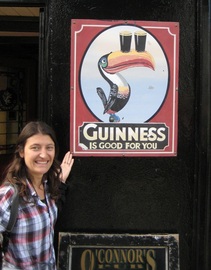 My spiritual mentor ;) But as our trip continued through the UK and Scotland, I still hadn’t opened the Kindle and had brought the question up to Neda several times as to whether I should keep it or not. Even though I had made the decision and reviewed the pros and cons, I was still having trouble letting go of the fact that the Kindle could have been had for about $55 less. Finally, in Galway in Southern Ireland, when I brought it up one more time to Neda, she said something very wise to me. She said, “Sweetie, why don’t you just make that $55 your spiritual practice. Consider it a payment for learning to let go of the other possibilities that are torturing you and to accept what is.” What sage advice from my spiritual partner! It is so important to find those situations in our lives that we have difficulty accepting and practice with them. In this case, the actual situation was as close to meaningless as possible and I was still making myself suffer over it! 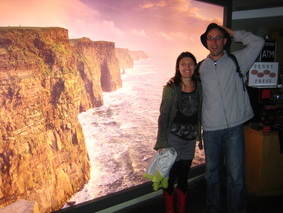 The best view we had of Moher Further opportunities for acceptance were provided throughout Southern Ireland with what is sometimes a traveler’s bane and sometimes an ally: the weather! As we traveled south from Derry to the port city of Galway, the clouds darkened. Our day trip to the Aran Islands was cold with intermittent spitting rain the whole time. The next day we headed to the Cliffs of Moher, where an enduring fog made this our best picture! We only had one day to see this wonder of the natural world, but the weather just didn’t want to cooperate. We could rage against the situation, but nothing would change in the end. Only accepting the situation would release us from the suffering of what could have been. I do understand that there are friends and family in our lives struggling to accept much more difficult situations than paying a bit too much for an electronic device or having bad weather. For them the issue of acceptance is even more difficult, though I think ultimately it is still the only path to relief from suffering. 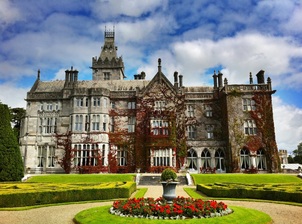 Adare Manor was stunning Luckily, Southern Ireland didn’t continue to test our acceptance of inclement weather. Instead, as we traveled down to Limerick to visit Iain’s friend Irina, the weather took a turn for the better. Irina, a local in Limerick for the past 12 years, generously took us to the best sites the region had to offer. On the first day we hiked through the Gap of Dunloe, enjoyed amazing views of the Ring of Kerry, and had a pint in the tidy town of Killarney. We also visited the beautiful gardens at Muckross House (set within Killarney National Park) and had lunch overlooking a ruined castle. 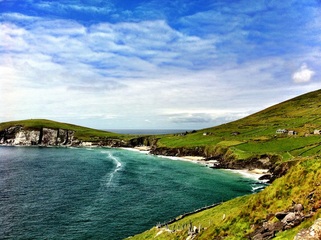 The blaskets on the edge of Dingle The next day we visited the beautiful Dingle peninsula, which has sweeping views of distant isles, hidden beaches, and the friendliest dolphin in history. Fungie, the Dingle dolphin, has lived in the bay of Dingle for nearly 30 years. While most dolphins migrate to warmer waters during the winter, Fungie enjoys the attention of the tourists too much and stays in Dingle the whole year (he is not fed by humans or domesticated in any way). It was a lot of fun to spot him popping out of the water to greet us as we cruised around the harbor. Unfortunately, the company running the tour puts 4-5 boats in the water at once during high season, limiting how much Fungie can do. But Irina’s friend caught this video of Fungie really performing when just one boat was out this past winter. After Dingle, Irina helped us make up for not seeing the Cliffs of Moher by taking us to Ballybunnion, where the local cliffs and rock formations are spectacular and completely non-touristic. We left Southern Ireland for a short stopover in Hahn, Germany, where we visited the cute town of Kastellaun for some Germany beers, a ruined castle and a beautiful hike through the local woods. Now we head back to Bulgaria and wait for our friends Christie & Brett to arrive so we can pay the hospitality forward with a tour of our country! To see the pics of Southern Ireland click here: To see the pics of Kastellaun click here: in memorium
|